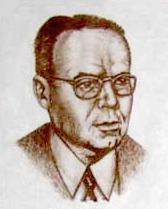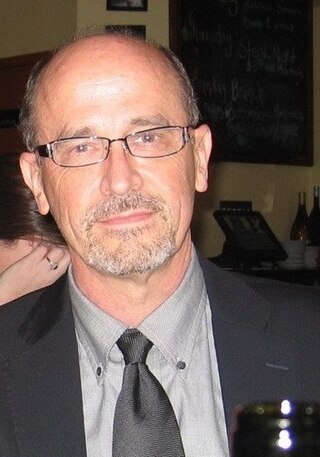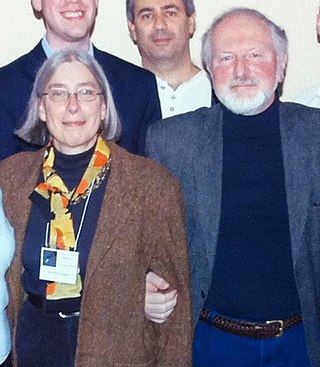
An astronomer is a scientist in the field of astronomy who focuses their studies on a specific question or field outside the scope of Earth. They observe astronomical objects such as stars, planets, moons, comets and galaxies – in either observational or theoretical astronomy. Examples of topics or fields astronomers study include planetary science, solar astronomy, the origin or evolution of stars, or the formation of galaxies. A related but distinct subject is physical cosmology, which studies the Universe as a whole.
George Ogden Abell was an American educator. Teaching at UCLA, priorly he worked as a research astronomer, administrator, as a popularizer of science and of education, and as a skeptic. He earned his B.S. in 1951, his M.S. in 1952 and his Ph.D. in 1957, all from the California Institute of Technology. He was a Ph.D. student under Donald Osterbrock. His astronomical career began as a tour guide at the Griffith Observatory in Los Angeles. Abell made great contributions to astronomical knowledge which resulted from his work during and after the National Geographic Society - Palomar Observatory Sky Survey, especially concerning clusters of galaxies and planetary nebulae. A galaxy, an asteroid, a periodic comet, and an observatory are all named in his honor. His teaching career extended beyond the campus of UCLA to the high school student oriented Summer Science Program, and educational television. He not only taught about science but also about what is not science. He was an originating member of the Committee on Scientific Investigation of Claims of the Paranormal now known as the Committee for Skeptical Inquiry.

Otto Lyudvigovich Struve was a Russian-American astronomer of Baltic German origin. Otto was the descendant of famous astronomers of the Struve family; he was the son of Ludwig Struve, grandson of Otto Wilhelm von Struve and great-grandson of Friedrich Georg Wilhelm von Struve. He was also the nephew of Karl Hermann Struve.

Charles Dillon Perrine was an American astronomer at the Lick Observatory in California (1893-1909) who moved to Cordoba, Argentina to accept the position of Director of the Argentine National Observatory (1909-1936). The Cordoba Observatory under Perrine's direction made the first attempts to prove Einstein's theory of relativity by astronomical observation of the deflection of starlight near the Sun during the solar eclipse of October 10, 1912 in Cristina (Brazil), and the solar eclipse of August 21, 1914 at Feodosia, Crimea, Russian Empire. Rain in 1912 and clouds in 1914 prevented results.

George A. Van Biesbroeck was a Belgian–American astronomer. He worked at observatories in Belgium, Germany and the United States. He specialized in the observation of double stars, asteroids and comets. He is notable for his long career as an observational astronomer.

The Astronomical Society of the Pacific (ASP) is an American scientific and educational organization, founded in San Francisco on February 7, 1889, immediately following the solar eclipse of January 1, 1889. Its name derives from its origins on the Pacific Coast, but today it has members all over the country and the world. It has the legal status of a nonprofit organization.
The George Van Biesbroeck Prize is an award for long-term achievements in the field of astronomy. According to the American Astronomical Society awards website; "The Van Biesbroeck prize is normally awarded every two years and honors a living individual for long-term extraordinary or unselfish service to astronomy, often beyond the requirements of his or her paid position."

Aden B. Meinel was an American astronomer. He retired in 1993 as a distinguished scientist at the Jet Propulsion Laboratory. He also held the rank of professor emeritus at the University of Arizona College of Optical Sciences. His research interests have included upper atmospheric physics, glass technology, optical design, instrumentation and space systems.

Virginia Louise Trimble is an American astronomer specializing in the structure and evolution of stars and galaxies, and the history of astronomy. She has published more than 600 works in Astrophysics, and dozens of other works in the history of other sciences. She is famous for an annual review of astronomy and astrophysics research that was published in the Publications of the Astronomical Society of the Pacific, and often gives summary reviews at astrophysical conferences. In 2018, she was elected a Patron of the American Astronomical Society, for her many years of intellectual, organizational, and financial contributions to the society.
Jay Myron Pasachoff was an American astronomer. Pasachoff was Field Memorial Professor of Astronomy at Williams College and the author of textbooks and tradebooks in astronomy, physics, mathematics, and other sciences.

The University of Illinois Astronomical Observatory, located at 901 S. Mathews Avenue in Urbana, Illinois, on the campus of the University of Illinois Urbana–Champaign, was built in 1896, and was designed by Charles A. Gunn. It was listed on the National Register of Historic Places on November 6, 1986, and on December 20, 1989, was designated a National Historic Landmark.

Nicholas B. Suntzeff is an American astronomer and cosmologist. He is a University Distinguished Professor and holds the Mitchell/Heep/Munnerlyn Chair of Observational Astronomy in the Department of Physics & Astronomy at Texas A&M University where he is Director of the Astronomy Program. He is an observational astronomer specializing in cosmology, supernovae, stellar populations, and astronomical instrumentation. With Brian Schmidt he founded the High-z Supernova Search Team, which was honored with the Nobel Prize in Physics in 2011 to Schmidt and Adam Riess.

Andrew Fraknoi is a retired professor of astronomy recognized for his lifetime of work using everyday language to make astronomy more accessible and popular for both students and the general public. In 2017 Fraknoi retired from his position as Chair of the Department of Astronomy at Foothill College. In retirement he continues to teach through the Fromm Institute for Lifelong Learning and the Osher Lifelong Learning Institute at San Francisco State University, to give public lectures, and to add to his body of written work. He is the recipient of numerous awards and honors in his field.
The Marc Aaronson Memorial Lectureship, also known as the Aaronson Prize, is an award of the University of Arizona Department of Astronomy and Steward Observatory which promotes and recognizes excellence in astronomical research. It is named after astronomer Marc Aaronson, who died in 1987 in an accident while making astronomical observations. He was 36 years old.

Martha Patricia Haynes is an American astronomer who specializes in radio astronomy and extragalactic astronomy. She is the distinguished professor of arts and sciences in astronomy at Cornell University. She has been on a number of high-level committees within the US and International Astronomical Community, including advisory committee for the Division of Engineering and Physical Sciences of the National Academies (2003–2008) and Astronomy and Astrophysics Decadal Review. She was a vice-president of the executive committee of the International Astronomical Union from 2006–2012, and was on the board of trustees of Associated Universities Inc from 1994 until 2016, serving two terms as board chair and one year as interim president.
Christopher David Impey is a British astronomer, educator, and author. He has been a faculty member at the University of Arizona since 1986. Impey has done research on observational cosmology, in particular low surface brightness galaxies, the intergalactic medium, and surveys of active galaxies and quasars. As an educator, he has pioneered the use of instructional technology for teaching science to undergraduate non-science majors. He has written many technical articles and a series of popular science books including The Living Cosmos, How It Began, How It Ends: From You to the Universe, Dreams of Other Worlds, and Humble Before the Void. He served as Vice-President of the American Astronomical Society, he is a Fellow of the American Association for the Advancement of Science, and a Howard Hughes Medical Institute Professor. He serves on the Advisory Council of METI.

Claudia Megan Urry is an American astrophysicist, who has served as the President of the American Astronomical Society, as chair of the Department of Physics at Yale University, and as part of the Hubble Space Telescope faculty. She is currently the Israel Munson Professor of Physics and Astronomy at Yale University and Director of the Yale Center for Astronomy and Astrophysics. Urry is notable not only for her contributions to astronomy and astrophysics, including work on black holes and multiwavelength surveys, but also for her work addressing sexism and sex equality in astronomy, science, and academia more generally.

Debra Meloy Elmegreen is an American astronomer. She was the first woman to graduate from Princeton University with a degree in astrophysics, and she was the first female post-doctoral researcher at the Carnegie Observatories.
Hannah Steele Pettit, also known as Hannah Bard Steele Pettit, was an American astronomer who spent a notable amount of her career working as an assistant at the Yerkes Observatory, where she and her husband Edison Pettit jointly published photographs on the corona of a solar eclipse.

Marcia Jean Rieke is an American astronomer. She is a Regents' Professor of Astronomy and associate department head at the University of Arizona. Rieke is the Principal Investigator on the near-infrared camera (NIRCam) for the James Webb Space Telescope (JWST). She has also served as the deputy-Principal Investigator on the Near Infrared Camera and Multi-Object Spectrometer (NICMOS) for the Hubble Space Telescope (HST), and as the co-investigator for the multiband imaging photometer on the Spitzer Space Telescope, where she also acted as an outreach coordinator and a member of the Science Working Group. Rieke was also involved with several infrared ground-based observatories, including the MMT Observatory in Arizona. She was vice chair for Program Prioritization of the Astro2010 Decadal Survey Committee, "New Worlds, New Horizons". Marcia Rieke is considered by many to be one of the "founding mothers" of infrared astronomy, along with Judith Pipher.













